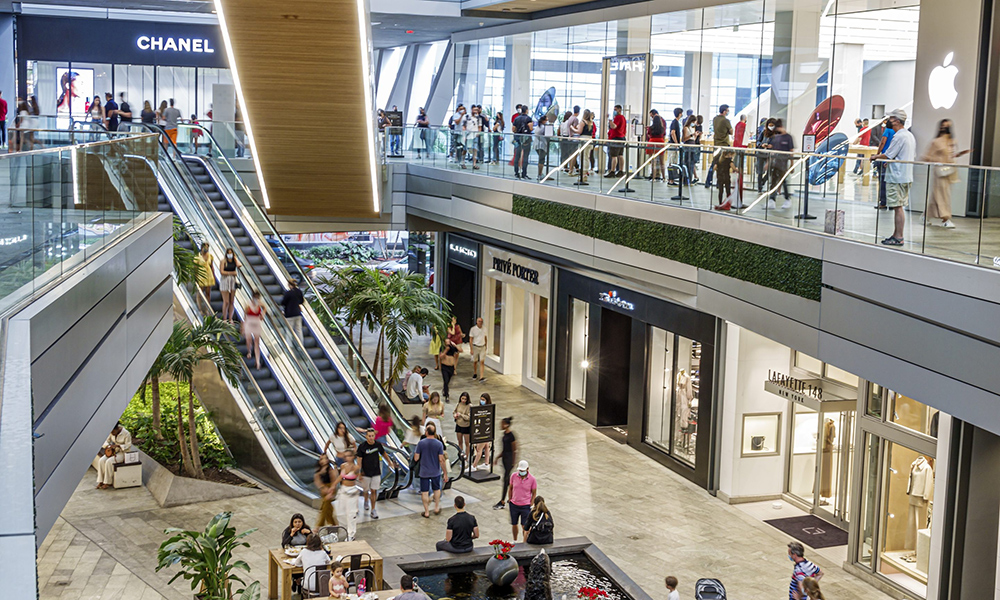
如果你在为自己喜爱的一些品牌的破产而难过,那么你就需要知道:事实证明,这也许正是你附近的购物中心的灯还亮着的原因。
长期以来,人们一直认为实体零售业正在被在线零售巨头挤出市场,但一份最新的报告发现,一些购物中心的经营状况实际上比新冠疫情前还要好。
美国的消费者似乎很是思念阔别已久的购物中心,零售业咨询机构Coresight Research的数据显示,他们现在其实比新冠疫情前更经常光顾当地的购物中心。
在所谓的高档购物中心(即提供奢侈品零售服务和入驻了重要新品牌的购物中心)以及中低档购物中心(即迎合较低收入消费者需求的购物中心),客流量均有所上升。
高档购物中心的客流量上涨了12%,低档购物中心的客流量则上涨了10%。
与此同时,购物中心的入驻率也恢复良好。
最高档次的购物中心的入驻率回升至95.1%,仅比新冠疫情前低0.1%;其他购物中心的入驻率为89.1%,而新冠疫情前为91.6%。
但据专家称,购物中心零售商组合的微小变化实际上可能是好事。
世邦魏理仕(CBRE)的美洲零售研究主管布兰登·伊斯纳对美国有线电视新闻网(CNN)表示:“对于那些喜欢逛购物中心的人来说,他们会希望每隔一段时间就有一些新店。”
“再想到Bed Bath & Beyond目前还在腾出零售空间,这其实对零售业而言是好事一桩。”
伊斯纳称,房东们很高兴能够收回这些零售空间,因为如此一来他们就可以收取更高的租金,同时想打入市场的新零售商也获得了机会。
根据针对公共购物中心运营商提供的数据的研究,高档购物中心与非高档购物中心的总收入均实现增长。
奢侈品热潮
得益于常年入驻其中的知名品牌的热潮,高档购物中心可能表现更佳。
消费者似乎并没有被对通胀或者日益迫近的衰退的担忧吓退,依然在名牌服装上大肆挥霍。
全球最大的时尚品牌路威酩轩(LVMH),即酩悦·轩尼诗-路易·威登集团(Moët Hennessy Louis Vuitton),2023年上半年的业绩“相当理想”。
今年7月,这家由世界第二富豪贝尔纳·阿尔诺拥有的集团公布,该集团2023年上半年的收入为422亿欧元(约457亿美元),同比增长15%,而有机收入同比增长17%。
除需求保持强劲外,奢侈品消费者还呈现出年轻化的趋势。
根据最新发布的《贝恩公司-意大利奢侈品行业协会奢侈品研究》(Bain & Company–Altagamma Luxury Study),2022年,Y世代(1982年至1994年出生的一代,也被称为千禧一代)和Z世代(20世纪90年代中期至21世纪00年代中期出生的一代)贡献了奢侈品市场全部的增长。
该报告指出,由于Z世代从15岁起就开始迷上了高价商品,而他们的后继者Alpha世代预计也会如此,到本个十年末,个人奢侈品市场市值将攀升至约5,400亿欧元至5,800亿欧元(约5,850亿美元至6,280亿美元),与2022年相比增长至少60%。
光环效应
事实证明,那些接纳在线零售商而非与之对抗的购物中心不仅存活了下来,还在蓬勃发展。
零售业分析机构Coresight Research表示,发展多渠道的零售方式对现代零售业来说是“必要的”,并称进入实体店在线零售商(进入在线零售市场的实体店零售商亦然)共同形成了“光环效应”。
Brookfield Property Group、Macerich、西蒙房地产集团(Simon Property Group)及Taubman Centers等高档零售购物中心的运营商都报告了这一趋势,称消费者正在返回实体店和恢复在线购物。
在今年6月的最新财报电话会议上,Macerich的首席执行官汤姆·奥赫恩说:“租赁量依然保持在历史最高值。我们的入驻率相比去年同期增长了80个基点,较上一季度环比增长了40个基点。”
“消费者的购物、外出就餐和旅行消费都达到了新冠疫情前的水平。”(财富中文网)
译者:中慧言-刘嘉欢
如果你在为自己喜爱的一些品牌的破产而难过,那么你就需要知道:事实证明,这也许正是你附近的购物中心的灯还亮着的原因。
长期以来,人们一直认为实体零售业正在被在线零售巨头挤出市场,但一份最新的报告发现,一些购物中心的经营状况实际上比新冠疫情前还要好。
美国的消费者似乎很是思念阔别已久的购物中心,零售业咨询机构Coresight Research的数据显示,他们现在其实比新冠疫情前更经常光顾当地的购物中心。
在所谓的高档购物中心(即提供奢侈品零售服务和入驻了重要新品牌的购物中心)以及中低档购物中心(即迎合较低收入消费者需求的购物中心),客流量均有所上升。
高档购物中心的客流量上涨了12%,低档购物中心的客流量则上涨了10%。
与此同时,购物中心的入驻率也恢复良好。
最高档次的购物中心的入驻率回升至95.1%,仅比新冠疫情前低0.1%;其他购物中心的入驻率为89.1%,而新冠疫情前为91.6%。
但据专家称,购物中心零售商组合的微小变化实际上可能是好事。
世邦魏理仕(CBRE)的美洲零售研究主管布兰登·伊斯纳对美国有线电视新闻网(CNN)表示:“对于那些喜欢逛购物中心的人来说,他们会希望每隔一段时间就有一些新店。”
“再想到Bed Bath & Beyond目前还在腾出零售空间,这其实对零售业而言是好事一桩。”
伊斯纳称,房东们很高兴能够收回这些零售空间,因为如此一来他们就可以收取更高的租金,同时想打入市场的新零售商也获得了机会。
根据针对公共购物中心运营商提供的数据的研究,高档购物中心与非高档购物中心的总收入均实现增长。
奢侈品热潮
得益于常年入驻其中的知名品牌的热潮,高档购物中心可能表现更佳。
消费者似乎并没有被对通胀或者日益迫近的衰退的担忧吓退,依然在名牌服装上大肆挥霍。
全球最大的时尚品牌路威酩轩(LVMH),即酩悦·轩尼诗-路易·威登集团(Moët Hennessy Louis Vuitton),2023年上半年的业绩“相当理想”。
今年7月,这家由世界第二富豪贝尔纳·阿尔诺拥有的集团公布,该集团2023年上半年的收入为422亿欧元(约457亿美元),同比增长15%,而有机收入同比增长17%。
除需求保持强劲外,奢侈品消费者还呈现出年轻化的趋势。
根据最新发布的《贝恩公司-意大利奢侈品行业协会奢侈品研究》(Bain & Company–Altagamma Luxury Study),2022年,Y世代(1982年至1994年出生的一代,也被称为千禧一代)和Z世代(20世纪90年代中期至21世纪00年代中期出生的一代)贡献了奢侈品市场全部的增长。
该报告指出,由于Z世代从15岁起就开始迷上了高价商品,而他们的后继者Alpha世代预计也会如此,到本个十年末,个人奢侈品市场市值将攀升至约5,400亿欧元至5,800亿欧元(约5,850亿美元至6,280亿美元),与2022年相比增长至少60%。
光环效应
事实证明,那些接纳在线零售商而非与之对抗的购物中心不仅存活了下来,还在蓬勃发展。
零售业分析机构Coresight Research表示,发展多渠道的零售方式对现代零售业来说是“必要的”,并称进入实体店在线零售商(进入在线零售市场的实体店零售商亦然)共同形成了“光环效应”。
Brookfield Property Group、Macerich、西蒙房地产集团(Simon Property Group)及Taubman Centers等高档零售购物中心的运营商都报告了这一趋势,称消费者正在返回实体店和恢复在线购物。
在今年6月的最新财报电话会议上,Macerich的首席执行官汤姆·奥赫恩说:“租赁量依然保持在历史最高值。我们的入驻率相比去年同期增长了80个基点,较上一季度环比增长了40个基点。”
“消费者的购物、外出就餐和旅行消费都达到了新冠疫情前的水平。”(财富中文网)
译者:中慧言-刘嘉欢
If you’re sad to see some of your favorite brands going bust, it turns out that might be the reason the lights are still on at your nearby shopping mall.
Contrary to a long-held opinion that brick-and-mortar retail is being muscled out by online giants, a new report has found that some shopping centers are actually faring even better than before the pandemic.
Absence seems to have made the heart grow fonder for American shoppers, with the data from Coresight Research revealing that consumers are actually using their local malls more than they were before the pandemic.
Across so-called top-tier malls—those which offer luxury retail as well as new and noteworthy brands—and mid- and lower-tier malls—which cater to lower-income shoppers—footfall is up.
For top-tier malls, the number of visitors is up 12%, while lower-tiered malls are up 10%.
Meanwhile, occupancy has also recovered well.
In the highest-quality malls, occupancy is back up to 95.1%, just 0.1% lower than before the pandemic, and in other malls the figure stands at 89.1% compared to 91.6% before the pandemic.
However, a bit of turnover on the lineup in shopping centers might actually be a good thing, according to experts.
“For people who go to the malls, they’re going to want some fresh new stores every once in a while,” Brandon Isner, CBRE’s head of retail research for the Americas, told CNN.
“Take into account the Bed Bath & Beyond retail space that’s being vacated as we speak—it’s turning out that’s actually kind of a good thing for retail.”
Isner said that landlords are pleased to have the space back so they can charge higher rents, while it also frees up opportunities for new retailers trying to break into the market.
Total revenue is also up in both top-tier and non-top-tier malls, according to the research which gathered data from public mall operators.
A boom in luxury
Higher-end malls may be faring better courtesy of the famous brands which call their centers home.
Seemingly undeterred by fears of inflation or a looming recession, shoppers are continuing to splash out on designer gear.
LVMH—Moët Hennessy Louis Vuitton—the world’s biggest designer fashion house, reported an “excellent” first half of 2023.
In July the group, owned by the world’s second-richest man Bernard Arnault, reported revenue of €42.2 billion ($45.7 billion) in the first half of 2023, up 15%, while organic revenue growth was 17% compared to the same period in 2022.
And as well as seeing continuing demand, luxury shoppers are only getting younger.
According to the latest Bain & Company–Altagamma Luxury Study, Gen Y—those born between 1982 and 1994, also known as millennials—and Gen Z—those born from the mid-’90s to the mid-’00s—accounted for the entire growth of the luxury market in 2022.
With Gen Z already hooked on high-ticket items from the age of 15—and their successors Generation Alpha expected to do the same according to the report—the personal luxury market is set to climb to around €540–€580 billion ($585 to $628 billion) by the end of the decade, a rise of 60% or more compared to 2022.
The halo effect
It turns out malls that are embracing online retailers instead of fighting them are also the ones that are not only surviving but thriving.
Coresight Research said developing a multi-channel approach to sales is a “necessity” of modern retail, and dubbed the combination of online retailers moving into physical stores—and vice versa—the “halo effect.”
Top-tier retail mall operators like Brookfield Property Group, Macerich, Simon Property Group, and Taubman Centers have all reported such a trend, saying consumers are returning to stores as well as shopping online.
During its most recent earnings call in June Tom O’Hern, CEO of Macerich, said: “Leasing volumes [have] continued at a record level. We had an 80-basis-point gain in occupancy compared to a year ago and 40-basis-point gain compared to last quarter.
“Consumers are shopping, eating out, and traveling at pre-pandemic levels.”






